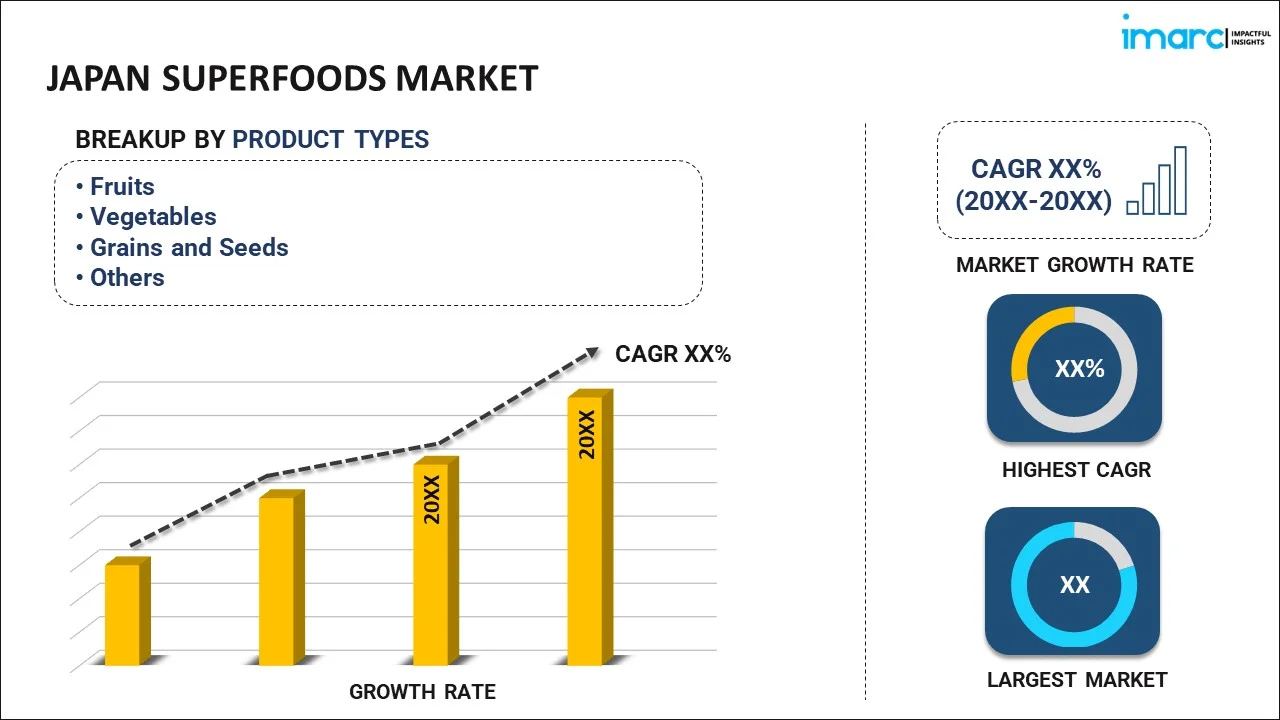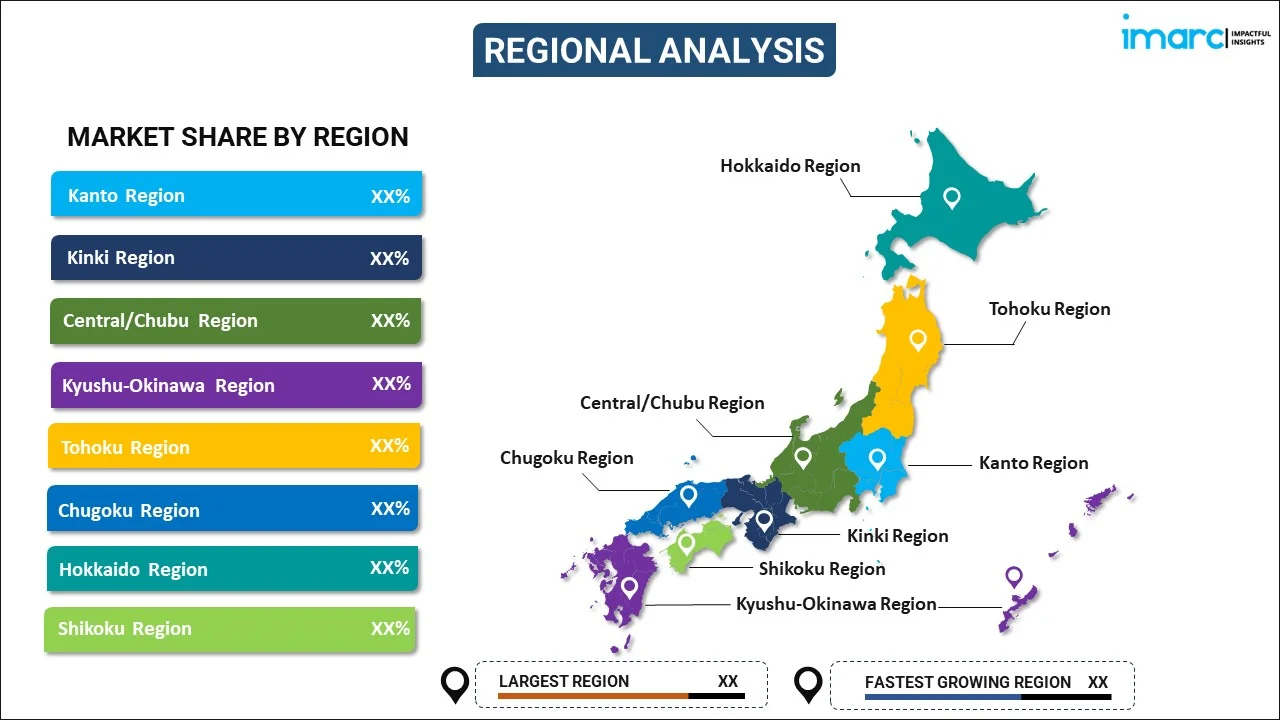
Japan Superfoods Market Report by Product Type (Fruits, Vegetables, Grains and Seeds, Herbs and Roots, Meat, and Others), Application (Bakery and Confectionery, Beverages, Supplements, Convenience/Ready-to-Eat Foods, and Others), Distribution Channel (Supermarkets and Hypermarkets, Convenience Stores, Specialty Stores, Independent Small Grocery Stores, Online Sales, and Others), and Region 2025-2033
Market Overview:
The Japan superfoods market size reached USD 10.9 Billion in 2024. Looking forward, IMARC Group expects the market to reach USD 20.8 Billion by 2033, exhibiting a growth rate (CAGR) of 7.4% during 2025-2033. The growing demand for ready-to-eat (RTE) food products among individuals due to busy lifestyles and hectic working schedules, wide availability through various distribution channels, and increasing preference for healthy eating habits and maintaining a healthy body represent some of the key factors driving the market.
|
Report Attribute
|
Key Statistics
|
|---|---|
|
Base Year
|
2024 |
|
Forecast Years
|
2025-2033
|
|
Historical Years
|
2019-2024
|
| Market Size in 2024 | USD 10.9 Billion |
| Market Forecast in 2033 | USD 20.8 Billion |
| Market Growth Rate (2025-2033) | 7.4% |
Superfoods are nutrient-dense and natural foods that are a rich source of vitamins C, A, and K, iron, calcium, potassium, antioxidants, and other bioactive compounds. They are widely available as berries, leaf greens, salmon, nuts and seeds, quinoa, and green tea. They provide anti-inflammatory effects that protect the body against oxidative stress and support brain health. They can boost energy levels and help in disease prevention. They assist in promoting heart health and boosting the immune system of individuals. They aid in maintaining healthy bones, improving digestion, and supporting optimal vision. Besides this, they are beneficial in maintaining healthy muscles and overall body function. As they can help in lowering cholesterol levels and reducing the risk of various chronic disorders, such as heart disease, cancer, asthma, cystic fibroids, arthritis, and diabetes, the demand for superfoods is rising in Japan.
Japan Superfoods Market Trends:
At present, the rising adoption of healthy eating habits among individuals represents one of the key factors supporting the growth of the market in Japan. Besides this, the increasing consumption of superfoods, as they assist in promoting cardiovascular health and supporting weight management among people, is strengthening the growth of the market in the country. Additionally, there is a rise in the demand for cost-effective, easy to consume, high quality, premium, and convenient food products among individuals in Japan. This, coupled with the increasing preference for dietary choices and preventive healthcare practices, is bolstering the growth of the market. Apart from this, the growing demand for superfoods due to the increasing awareness about maintaining a healthy lifestyle is positively influencing the market in the country. In addition, the wide availability of superfoods through various distribution channels, such as supermarkets, hypermarkets, and convenience, specialty, and online stores, in Japan is contributing to the growth of the market. Moreover, the increasing number of cafes, restaurants, hotels, pubs, clubs, and bars is offering lucrative growth opportunities to industry investors in the country. In line with this, the growing demand for superfoods due to the increasing influence of Western culture and social media on individuals is offering a positive market outlook in Japan. In addition, the rising demand for ready-to-eat (RTE) superfoods among individuals due to busy lifestyles and hectic working schedules is propelling the growth of the market in the country. Furthermore, the increasing adoption of superfoods on account of the rising health consciousness among individuals in the country is impelling the growth of the market.
Japan Superfoods Market Segmentation:
IMARC Group provides an analysis of the key trends in each segment of the Japan superfoods market report, along with forecasts for 2025-2033. Our report has categorized the market based on product type, application, and distribution channel.
Product Type Insights:

To get more information on this market, Request Sample
- Fruits
- Vegetables
- Grains and Seeds
- Herbs and Roots
- Meat
- Others
The report has provided a detailed breakup and analysis of the market based on the product type. This includes fruits, vegetables, grains and seeds, herbs and roots, meat, and others.
Application Insights:
- Bakery and Confectionery
- Beverages
- Supplements
- Convenience/Ready-to-Eat Foods
- Others
A detailed breakup and analysis of the market based on the application has also been provided in the report. This includes bakery and confectionery, beverages, supplements, convenience or ready-to-eat foods, and others.
Distribution Channel Insights:
- Supermarkets and Hypermarkets
- Convenience Stores
- Specialty Stores
- Independent Small Grocery Stores
- Online Sales
- Others
A detailed breakup and analysis of the market based on the distribution channel has also been provided in the report. This includes supermarkets and hypermarkets, convenience stores, specialty stores, independent small grocery stores, online sales, and others.
Region Insights:

- Kanto Region
- Kinki Region
- Central/ Chubu Region
- Kyushu-Okinawa Region
- Tohoku Region
- Chugoku Region
- Hokkaido Region
- Shikoku Region
The report has also provided a comprehensive analysis of all the major regional markets, which include Kanto Region, Kinki Region, Central/ Chubu Region, Kyushu-Okinawa Region, Tohoku Region, Chugoku Region, Hokkaido Region, and Shikoku Region.
Competitive Landscape:
The report has also provided a comprehensive analysis of the competitive landscape in the Japan superfoods market. Competitive analysis such as market structure, key player positioning, top winning strategies, competitive dashboard, and company evaluation quadrant has been covered in the report. Also, detailed profiles of all major companies have been provided.
Japan Superfoods Market:
- September 2025: Leaft Foods, based in New Zealand, collaborates with Lacto Japan to incorporate its leaf protein into essential segments like bakery and dairy products. This alliance seeks to enhance sustainable nutrition in the Asia Pacific by combining Leaft’s technology with Lacto Japan’s well-established role in food manufacturing and dairy.
- August 2025: The Indonesian and Japanese governments, in collaboration with the Japan International Cooperation Agency (JICA), are conducting in-depth training on avocado cultivation for Palestine to enhance the production and marketing of the crop. This training runs from August 11 to 25 and involves 15 participants from the Palestinian government who will acquire knowledge about the entire process of avocado farming and marketing.
- June 2025: Japanese sweet maker Meiji is broadening its chocolate range with two new limited-edition items, offered across Japan. The latest variants – Almond Chocolate Crunch Okinawa Salt & Milk and Macadamia Chocolate Okinawa Salt & Premium Vanilla – prominently include Okinawa salt as an essential component. Almond Chocolate Crunch Okinawa Salt & Milk blends crunchy almonds with chocolate and puffed grains, enhanced by Okinawa salt, delivering a delightful sweet-salty taste and crisp texture.
- March 2025: Otsuka Pharmaceutical Company, Limited announced its decisions to introduce the latest product in its SOYJOY line of whole-soy nutrition bars, "SOYJOY Black Sesame," on March 17. Crafted from nutrient-dense black sesame, this low glycemic index (GI) item offers a robust sesame sensation accompanied by a deep aromatic taste.
Japan Superfoods Market Report Scope:
| Report Features | Details |
|---|---|
| Base Year of the Analysis | 2024 |
| Historical Period | 2019-2024 |
| Forecast Period | 2025-2033 |
| Units | Billion USD |
| Scope of the Report | Exploration of Historical and Forecast Trends, Industry Catalysts and Challenges, Segment-Wise Historical and Predictive Market Assessment:
|
| Product Types Covered | Fruits, Vegetables, Grains and Seeds, Herbs and Roots, Meat, Others |
| Applications Covered | Bakery and Confectionery, Beverages, Supplements, Convenience/Ready-to-Eat Foods, Others |
| Distribution Channels Covered | Supermarkets and Hypermarkets, Convenience Stores, Specialty Stores, Independent Small Grocery Stores, Online Sales, Others |
| Regions Covered | Kanto Region, Kinki Region, Central/ Chubu Region, Kyushu-Okinawa Region, Tohoku Region, Chugoku Region, Hokkaido Region, Shikoku Region |
| Customization Scope | 10% Free Customization |
| Post-Sale Analyst Support | 10-12 Weeks |
| Delivery Format | PDF and Excel through Email (We can also provide the editable version of the report in PPT/Word format on special request) |
Key Benefits for Stakeholders:
- IMARC’s report offers a comprehensive quantitative analysis of various market segments, historical and current market trends, market forecasts, and dynamics of the Japan superfoods market from 2019-2033.
- The research study provides the latest information on the market drivers, challenges, and opportunities in the Japan superfoods market.
- Porter's five forces analysis assist stakeholders in assessing the impact of new entrants, competitive rivalry, supplier power, buyer power, and the threat of substitution. It helps stakeholders to analyze the level of competition within the Japan superfoods industry and its attractiveness.
- Competitive landscape allows stakeholders to understand their competitive environment and provides an insight into the current positions of key players in the market.
Key Questions Answered in This Report
The superfoods market in Japan was valued at USD 10.9 Billion in 2024.
The Japan superfoods market is projected to exhibit a CAGR of 7.4% during 2025-2033, reaching a value of USD 20.8 Billion by 2033.
The Japan superfoods market is driven by rising health consciousness, aging demographics, and increasing demand for functional foods that support immunity and longevity. Growing interest in plant-based diets, government initiatives promoting wellness, and the influence of global food trends also fuel market growth, particularly among younger, urban consumers.
Need more help?
- Speak to our experienced analysts for insights on the current market scenarios.
- Include additional segments and countries to customize the report as per your requirement.
- Gain an unparalleled competitive advantage in your domain by understanding how to utilize the report and positively impacting your operations and revenue.
- For further assistance, please connect with our analysts.
 Request Customization
Request Customization
 Speak to an Analyst
Speak to an Analyst
 Request Brochure
Request Brochure
 Inquire Before Buying
Inquire Before Buying




.webp)




.webp)












